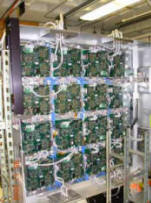
Handy Links
SLAC News Center
SLAC Today
- Subscribe
- Archives: Feb 2006-May 20, 2011
- Archives: May 23, 2011 and later
- Submit Feedback or Story Ideas
- About SLAC Today
SLAC News
Lab News
- Interactions
- Lightsources.org
- ILC NewsLine
- Int'l Science Grid This Week
- Fermilab Today
- Berkeley Lab News
- @brookhaven TODAY
- DOE Pulse
- CERN Courier
- DESY inForm
- US / LHC
SLAC Links
- Emergency
- Safety
- Policy Repository
- Site Entry Form

- Site Maps
- M & O Review
- Computing Status & Calendar
- SLAC Colloquium
- SLACspeak
- SLACspace
- SLAC Logo
- Café Menu
- Flea Market
- Web E-mail
- Marguerite Shuttle
- Discount Commuter Passes
-
Award Reporting Form
- SPIRES
- SciDoc
- Activity Groups
- Library
Stanford
Around the Bay
SLAC Researchers Develop Flight Software for LAT
 Nearly 350 miles above the Earth's surface, a perpetual storm of particles bombards an instrument
that records the path and strength of each particle that strikes it. This hail of particle collisions
creates 10 megabytes of data every second.
Nearly 350 miles above the Earth's surface, a perpetual storm of particles bombards an instrument
that records the path and strength of each particle that strikes it. This hail of particle collisions
creates 10 megabytes of data every second.
Running on a processor about a tenth as powerful as a consumer laptop, a computer program shrinks this data down to less than 150 kilobytes per second.
The instrument in this scenario is the Large Area Telescope (LAT) assembled at SLAC as part of the NASA-led Gamma-ray Large Area Space Telescope (GLAST) project, slated to launch in 2007. The LAT's flight software sifts through the millions of "events" registered on the instrumentís detectors, keeping only those potentially caused by gamma rays.
"To do this without losing information, we have to apply physics knowledge on the fly," says SLAC's Tony Waite, who along with JJ Russell, led the team that developed the flight software. "We can't just use a standard data compression program like gzip."
While the craft is in space, researchers will have about an hour of contact with it each day. This will be the only time available for the flight software to transmit the compressed data to Earth.
"The pipes are small and you don't get to turn them on often," says Waite.
The flight software configures the LAT to work in two modes: looking at the entire sky to construct a "gamma sky map," or zeroing in on gamma ray bursts, which typically last from a few seconds to a few hours.
Physical stresses during launch and exposure to radiation while in orbit will cause changes in the characteristics of the LAT hardware. Some components may fail. To keep the overall system functioning optimally, the flight software constantly recalibrates the hardware and troubleshoots problems. In space, both tasks are challenging.
"We can't climb up with a ladder and stick a probe into the LAT," says Russell.
—Chandra Shekhar
SLAC Today, May 23, 2006
Image: The LAT flight software test bed. Each square simulates one of the LAT's 16 towers. (Click on image for larger version.)